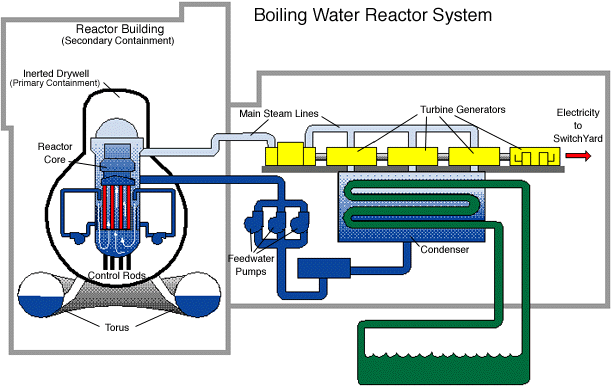I have been reading about the nuclear situation in Japan.
Sadly it would appear that the troubled plants are all based on the old GE "boiling water" reactor model. As I have written here before back in the 1970's my family was involved in successfully stopping the construction of a nuclear power plant across the road from our house.
During this time, as I high school student, I was very interested in the reactors and the technology they used. There were two main types: pressure vessel and boiling water (made exclusively by GE). Pressure vessel reactors are designed around the concept that a sealed loop of high-pressure water is the only thing that comes into contact with the nuclear fuel.
The water is heated by the reactor core, pumped around to what is called a heat exchanger where it is cooled, and then pumped back into the reactor for reheating. This water is highly radioactive and is basically sealed in the high-pressure piping. The heat exchanger is used to heat water to make steam in a secondary loop which drives the turbines that generate electricity.
The boiling water reactors work differently.
In these reactors the nuclear fuel heats water into steam that drives the electricity-generating turbines directly - hence the name "boiling water."
The safety issues, which are no doubt what's causing so much trouble in Japan, are related to the fact that a single break in the piping can cause the coolant flow out of the "boiling chamber". When this happen the fuel rods overheat and can melt - just as we see in Japan today.
Today of the 110 or so nuclear reactors in the USA 35 are "boiling water" types (see this).
Sadly, even as a kid in high school I knew that "boiling water" reactors were not as good as the "closed loop" types. Though I do not recall how my father and others in the area who were against the plant were able to find this out.
The reactors in Japan were probably not designed to withstand the types of earthquake shocks being felt there - certainly not the 8.9/9.1 being reported. These quakes appear to be damaging the cooling piping and causing the coolant to drain from the "boiling" vessel. When this occurs the fuel begins to react more intensely, heat up and melt the fuel rods.
Once the fuel rods melt they become distorted and can lead to a number of additional problems - deformation, loss of control, and so on.
One of the issues that was obvious in the early seventies was how the industry knew - at that point without the benefit of experience - that the safety systems in these plants (all nuclear plants, not just "boiling water" plants) would work in an emergency - particularly an unforeseen emergency. The arrogance of the designers and companies was fairly obvious - even to a 15 year old kid. Its unfortunate that the worst fears are being realized.
Six USA nuclear plants are configured identically to those with problem in Japan (see this).
Lexigraph has customers in Japan and we have worked extensively with the Japanese for several years on a variety of projects.
We hope and pray that things turn out well.

No comments:
Post a Comment